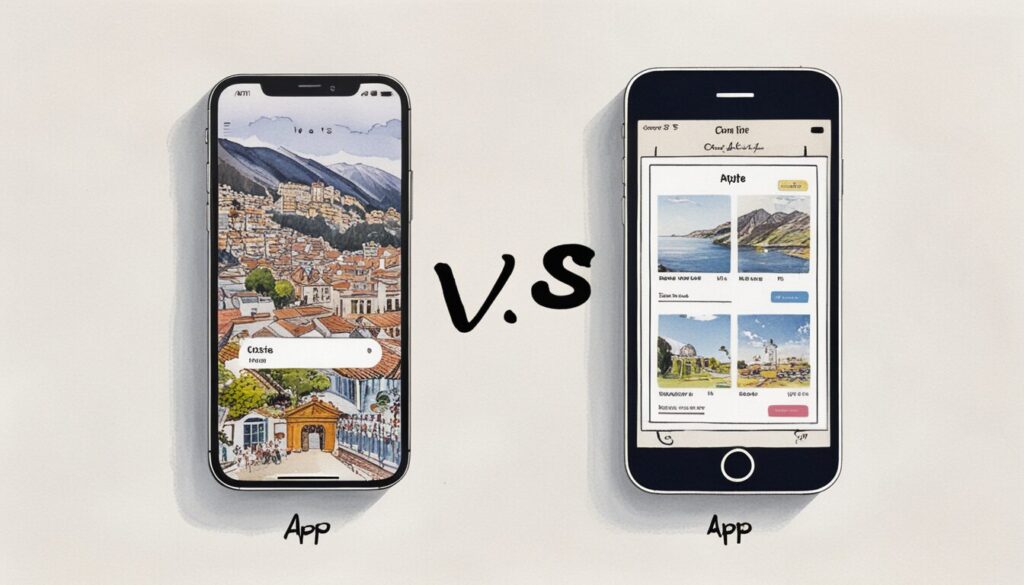Mobile App Development vs. Mobile Web Development: When, Why, and How
Did you know that over 6 billion people worldwide use smartphones? That’s more than 75% of the global population! With this staggering statistic, it’s no surprise that mobile app and web development are at the forefront of the digital world. As users demand faster, more intuitive, and visually engaging mobile experiences, developers face a crucial question: Should they create a mobile web app, a native app, or a hybrid app? The answer isn’t always clear-cut, as each option comes with its own advantages, challenges, and specific use cases.
If you’re struggling to decide which path to take or wondering how to optimize your mobile app development process, this guide is for you. We’ll explore the key differences between mobile app and web app development, uncover best practices, and share tools to help you succeed. Let’s dive in!
Mobile Web App vs. Native App vs. Hybrid App
- Mobile Web Apps: Web apps optimized for mobile devices, written in HTML/CSS, and accessed via browsers.
- Native Apps: Platform-specific applications built using languages like Java (Android) or Swift (iOS).
- Hybrid Apps: Apps developed with web technologies but run inside a native container for cross-platform functionality.
Choosing the right app type depends on your target audience, budget, and required features. Mobile web apps are often faster and cheaper to develop, particularly when targeting multiple devices. However, native apps can leverage hardware-specific features like accelerometers or cameras, offering superior performance. Hybrid apps, on the other hand, strike a balance by combining web technologies with native capabilities, making them ideal for cross-platform use.
Each option has its trade-offs. For example, while native apps deliver exceptional performance, they are costlier and take longer to develop. Conversely, hybrid apps might lack the seamlessness of native apps but offer flexibility and faster development. It’s crucial to research your audience’s preferences and technical requirements before making a decision.
Why Mobile Web Development Requires Detailed Planning
- Understanding your target audience and their needs.
- Accounting for differences between desktop and mobile browsers.
- Designing for varying screen sizes, orientations, and Retina displays.
- Ensuring compatibility with an ever-evolving device landscape.
Mobile web development isn’t just about shrinking your desktop site to fit a smaller screen. It requires detailed planning to address user behavior, device capabilities, and technical limitations. For instance, HTML5 features like the <video> tag’s autoplay functionality often don’t work on mobile browsers. Additionally, CSS properties like transitions may not be uniformly supported.
Consider the diversity of devices: shorter lifespans, different resolutions, and varying orientations. A successful mobile web app must adapt to all these variables. Tools like CSS3 media queries can help create responsive designs that cater to different screen sizes and orientations, ensuring a seamless and engaging user experience.
Optimizing Your Mobile Web Application for Performance
- Minimizing image load times through optimization tools like Kraken.io.
- Compressing JavaScript and CSS files for faster loading.
- Implementing server-side caching to reduce database queries.
- Utilizing Content Delivery Networks (CDNs) for media-heavy apps.
Performance optimization is critical. A slow-loading app frustrates users and drives them away—53% of mobile site visits are abandoned if loading takes longer than three seconds! Optimizing image sizes, compressing code, and using CDNs can significantly enhance loading speeds and user satisfaction.
CDNs, in particular, offer numerous benefits, including improved download performance, reduced latency, and better analytics. By distributing content across multiple servers worldwide, CDNs ensure users can access your app quickly, no matter where they are.
Best Tools for Mobile Web Development
- JavaScript frameworks: React or Ext JS for user-friendly interfaces.
- Responsive frameworks: TailwindCSS for responsive designs.
- Testing tools: Chrome DevTools, and BrowserStack for debugging and cross-browser testing.
The right tools can make all the difference. Frameworks like Google Material and Shadcn/ui simplify the development process by providing pre-built UI components, while TailwindCSS helps streamline responsive design. Testing tools like Chrome DevTools allow developers to debug code, emulate mobile environments, and optimize performance.
For example, Chrome DevTools’ mobile emulator lets you simulate touch events, throttle network speeds, and override device orientation, making it an invaluable resource for mobile web development. Similarly, BrowserStack enables testing across multiple devices without the need for physical hardware.
Debugging and Testing Mobile Web Apps
- Using browser-based developer tools for real-time debugging.
- Simulating mobile environments with emulators.
- Testing layout and compatibility with online tools like BrowserStack.
Debugging mobile web apps can be tricky, especially given the diversity of devices and browsers. Tools like Chrome DevTools simplify this process by offering features like dynamic inspection, remote debugging, and performance profiling. These tools allow you to identify and fix issues efficiently, ensuring your app runs smoothly across all platforms.
Additionally, platforms like BrowserStack and BitBar provide comprehensive testing environments, allowing you to evaluate your app’s layout, compatibility, and performance without needing access to a wide range of physical devices.
Conclusion
As mobile devices continue to dominate the digital landscape, choosing the right development approach—whether it’s a mobile web app, native app, or hybrid app—has never been more important. By understanding the unique benefits and challenges of each option, planning meticulously, and leveraging the right tools and frameworks, you can create mobile experiences that delight users and drive success.
Remember, performance optimization, responsive design, and thorough testing are non-negotiable when it comes to mobile web development. A slow or poorly designed app can quickly lose users, while a seamless, intuitive experience can make all the difference.
Ready to create a high-performing mobile web app? Start planning, choose the best tools for the job, and embrace the exciting world of mobile web development. The possibilities are endless!
